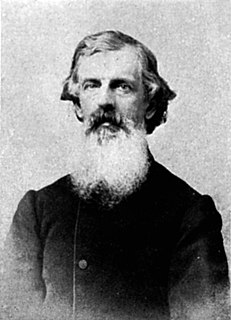
Lichenology is the branch of mycology that studies the lichens, symbiotic organisms made up of an intimate symbiotic association of a microscopic alga with a filamentous fungus.

Edward Tuckerman was an American botanist and professor who made significant contributions to the study of lichens and other alpine plants. He was a founding member of the Natural History Society of Boston and most of his career was spent at Amherst College. He did the majority of his collecting on the slopes of Mount Washington in the White Mountains of New Hampshire. Tuckerman Ravine was named in his honor. The standard botanical author abbreviation Tuck. is applied to species he described.
Speerschneidera is a single-species genus of lichen-forming fungi in the family Leprocaulaceae. The genus was circumscribed by Italian botanist Vittore Benedetto Antonio Trevisan de Saint-Léon in 1861, with Speerschneidera euploca as the type species. This lichen was originally described by Edward Tuckerman in 1858 as Physcia euploca. It is a crustose lichen found in the southern United States and Mexico.

Amandinea is a genus of lichenized fungi in the family Caliciaceae. Genetic studies indicates that the genus Amandinea and Buellia are the same, although this is not widely accepted.

This is a list of books in the English language which deal with Jersey and its geography, history, inhabitants, culture, biota, etc.

Pilophorus acicularis, commonly known as the nail lichen or the devil's matchstick lichen, is a species of matchstick lichen in the family Cladoniaceae.

Crustose lichens are lichens that form a crust which strongly adheres to the substrate, making separation from the substrate impossible without destruction. The basic structure of crustose lichens consists of a cortex layer, an algal layer, and a medulla. The upper cortex layer is differentiated and is usually pigmented. The algal layer lies beneath the cortex. The medulla fastens the lichen to the substrate and is made up of fungal hyphae. The surface of crustose lichens is characterized by branching cracks that periodically close in response to climatic variations such as alternate wetting and drying regimes.

Lecanora pringlei is a species of lichen in the family Lecanoraceae. It was originally described in 1883 as Lecidea pringlei by American botanist Edward Tuckerman. Ivan Mackenzie Lamb transferred it to Lecanora in 1939.

Xanthoparmelia lineola, commonly known as the tight rock-shield, is a foliose lichen species in the genus Xanthoparmelia. It is a common species with a temperate distribution. Found in North America and South Africa, it grows on rocks.
John Walter Thomson Jr. (1913–2009) was a Scottish-born American botanist and lichenologist, sometimes referred to as the "Dean of North American Lichens".
Thomas Hawkes Nash III is an American lichenologist. His research is about the biology and ecology of lichens, and the effects of air pollution on plants and lichens. He is known as an authority on the family Parmeliaceae. During his long career at the Arizona State University, he helped develop the lichen herbarium into a world-class collection with over 100,000 specimens representing more than 5000 species. In 2010, the year of his retirement, he was awarded the Acharius Medal for lifetime achievements in lichenology, and the following year had a Festschrift published in his honor.
Robert "Bob" Shaw Egan is a botanist and lichenologist, specializing in the family Parmeliaceae. He was the president of the American Bryological and Lichenological Society from 1999 to 2001.
Henry Willey was an American lichenologist. He was also the editor of the New Bedford, Massachusetts newspaper The Standard from 1856 until 1900.

Punctelia rudecta, commonly known as the rough speckled shield or the speckleback lichen, is a North American species of foliose lichen in the family Parmeliaceae. This species can be readily identified by the light color of the thallus underside, the relatively large lobes at the edges of the thallus, and the tiny white pores present on the top of the thallus that are characteristic of the genus Punctelia. The lichen is quite abundant and widespread in the eastern and southeastern United States, although it also occurs in Canada and northern Mexico, but is less common in these regions. The lichen usually grows on bark, and less commonly on shaded rocks. There are several lookalike Punctelia species; these can often be distinguished from P. rudecta by differences in distribution or in the nature of the reproductive structures present on the thallus.

Parmotrema gardneri is a species of foliose lichen in the family Parmeliaceae. It was first formally described in 1955 by Carroll William Dodge as Parmelia gardneri, from specimens collected in Brazil. Emmanuël Sérusiaux transferred it to the genus Parmotrema in 1984. In addition to South America, it is also found in Africa, Asia, and North America.
Calicium carolinianum is a species of lichen in the family Caliciaceae. It is endemic to the Gulf Coastal Plain region of the United States. The lichen contains norstictic acid, and has ascospores that measure 13–17 by 8–9 μm.
Rockefellera is a fungal genus in the family Pannariaceae. It is a monotypic genus, containing the single species Rockefellera crossophylla. The genus was circumscribed by James Lendemer and Erin Tripp in 2017. The generic name honors the Rockefeller family, "for their century-long support of North American conservation efforts, particularly with respect to national parks."

Xanthoparmelia subramigera is a lichen which belongs to the Xanthoparmelia genus.

Xanthoparmelia plittii is a lichen which belongs to the Xanthoparmelia genus.

Xanthoparmelia ajoensis is a lichen which belongs to the Xanthoparmelia genus. The lichen is uncommon and is listed as vulnerable by the Nature Conservatory.













